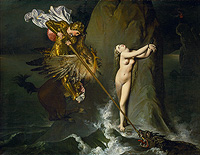
"Ingresque" eroticism
During his stay at the Villa Medici (the French Academy in Rome), Ingres devised three different prototypes for representing the female body: nude and seen from behind, reclining, and as a helpless figure in distress.
The Bather of Valpinçon, which the Academy sent to Paris in 1808, shows Ingres breaking with the ancient ideal and experimenting new forms. Choosing not to picture the model's face, and leaving no hint as to her particular personality, the painter has featured the woman seen from the back and fully naked save for a scarf and a bit of cloth. With this painting, Ingres defined an iconography, point of view and erotic atmosphere, which he was to re-create in subsequent works.
The Grande Odalisque is also shown from behind. Propped up on her left elbow, her right hand touching her left shin, she evokes a mood of voluptuous languor. Ingres carefully posed this image, curving the woman's body into a delicate arabesque, and adding Orientalist touches with her accessories.
The third prototype is represented in the painting Roger and Angelica: it is a helpless, martyred woman figure, depicted standing in an agony of distress amid a fantastic and desolate landscape.






